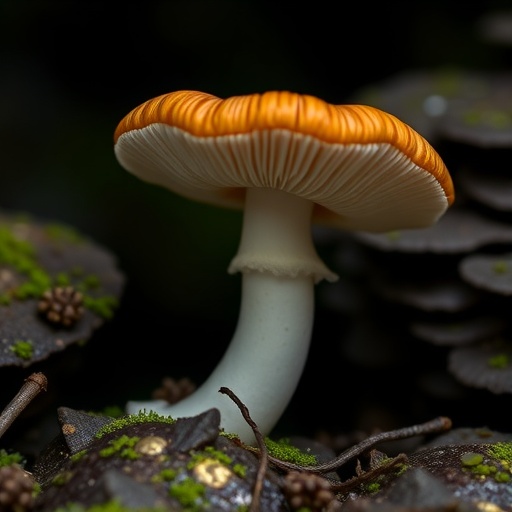Recent advancements in our understanding of mitochondrial genomes have opened new doors in the field of fungal evolution. A pivotal study by Wang et al. takes a close look at the mitochondrial genomes within the Lycoperaceae family of fungi, shedding light on the complexities of their intron dynamics and providing critical insights into their phylogenetic relationships. This investigation not only enhances our knowledge of fungal biology but also highlights the importance of genetic variation in evolutionary processes.
Mitochondria, often referred to as the powerhouses of cells, possess their own distinct genomes, separate from the nuclear DNA. This independence makes them an invaluable resource for scientists studying evolutionary biology. In the case of the Lycoperaceae family, characterized by its diversity and ecological significance, the mitochondrial genome serves as a critical element in unraveling their evolutionary pathways and lineage distinctions.
The study meticulously compares the mitochondrial genomes across various species within the Lycoperaceae family, with a keen eye on the introns present within these genomes. Introns, non-coding sequences that interrupt the coding regions of genes, play crucial roles in gene expression and regulation. By examining intron dynamics, the researchers can provide a clearer picture of how these fungi have adapted and evolved over time.
Another compelling aspect of the research relates to the phylogenetic relationships among Lycoperaceae fungi. Through comparative genomic analyses, the researchers constructed a phylogenetic tree, illustrating the evolutionary trajectories of these species. This approach not only elucidates the connections among different species but also reveals points of divergence and speciation, offering a comprehensive overview of how these organisms have diversified.
The methodologies employed by Wang et al. are notably rigorous, combining genomic sequencing with advanced bioinformatics techniques. Such an approach enables researchers to identify specific genetic markers and to correlate these markers with various evolutionary traits. As more mitochondrial genomes are sequenced and analyzed, the depth of understanding regarding fungal evolution continues to expand, providing new avenues for research and potential applications in fields like ecology and conservation biology.
Moreover, the findings of this study have broader implications for our understanding of mitochondrial evolution in general. The dynamics of introns within mitochondrial genomes have long been a topic of debate, and this research contributes substantial data to the ongoing discussion. By highlighting the variability of intron presence and structure among Lycoperaceae fungi, the study poses new questions regarding the evolutionary pressures that shape mitochondrial genomes across different taxa.
As we delve deeper into the evolutionary narrative told by mitochondrial genomes, it’s crucial to consider the ecological roles these fungi play. Lycoperaceae fungi are not only fascinating in their genetics but also vital to their ecosystems. Many species within this family are mycorrhizal or saprotrophic, meaning they engage in symbiotic relationships with plants or decompose organic matter. Understanding their evolutionary past can inform how they interact with their environments today and how they may respond to changes in climate and habitat.
The use of mitochondrial genomes in phylogenetic studies is gaining traction across various biological disciplines. Unlike nuclear DNA, mitochondrial genomes are typically more stable and evolve at different rates, making them apt for certain evolutionary investigations. This study fortifies the notion that mitochondrial analysis can yield significant insights, particularly when assessing relationships in groups with complicated evolutionary histories, like fungi.
In their comparative analysis, Wang et al. also raise the importance of gene transfer events, which can complicate our understanding of evolution. These events can mask true evolutionary relationships by enabling genes to hop between species, often blurring the lines on phylogenetic trees. The researchers put forth evidence supporting instances of horizontal gene transfer, complicating the assumed linearity of ancestral lineage.
The research not only paints a broader picture of the Lycoperaceae family but also emphasizes the need for a comprehensive approach in mycological research. As fungal species adapt to their environments, their genomes evolve alongside them, influenced by factors like climate, food availability, and interactions with other organisms. Every intron and gene variant tells a story of survival, adaptation, and resilience.
One of the most remarkable conclusions from Wang et al.’s research is the realization of the intricate relationships among species. The diversity within the Lycoperaceae family suggests a complex web of evolutionary history, bolstered by both environmental and genetic factors. This complexity compels researchers to broaden their investigative scopes, as understanding one family of fungi can enlighten our comprehension of fungal evolution as a whole.
In conclusion, the study authored by Wang et al. represents a significant contribution to mitochondrial genomics and fungal phylogenetics. The insights garnered from their comparative analysis of the Lycoperaceae family illuminate not only the evolutionary traumas experienced by these organisms but also reinforce the value of mitochondria as a source of genetic data. As researchers continue to delve into the evolutionary histories encapsulated in mitochondrial genomes, we inch closer to understanding the fundamental principles that govern life on Earth.
With the growing body of work surrounding mitochondrial genomes, the implications for biotechnology, agriculture, and medicine are profound. Continued exploration in this area can lead to better understanding of fungal pathogens, improved crop resilience, and innovative biotechnological applications. As we venture deeper into this genomic frontier, the potential for breakthroughs is limitless, indicating a vibrant future for research in genetic dynamics.
Subject of Research: Mitochondrial genomics and phylogenetic relationships in Lycoperaceae fungi.
Article Title: Comparative analysis of mitochondrial genomes in lycoperdaceae fungi reveals intron dynamics and phylogenetic relationships.
Article References:
Wang, X., Wang, G., Tao, J. et al. Comparative analysis of mitochondrial genomes in lycoperdaceae fungi reveals intron dynamics and phylogenetic relationships.
BMC Genomics 26, 742 (2025). https://doi.org/10.1186/s12864-025-11911-4
Image Credits: AI Generated
DOI: 10.1186/s12864-025-11911-4
Keywords: Mitochondrial genomes, Lycoperaceae, phylogenetics, intron dynamics, fungi evolution.




